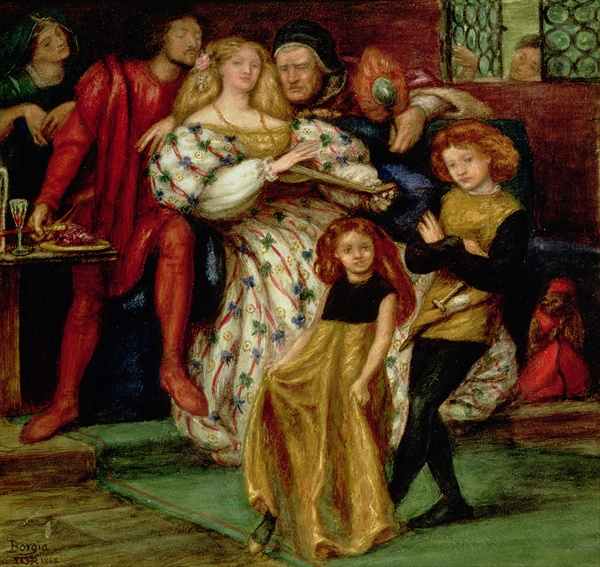The Borgias, or Borja, were a Spanish family from Valencia. There are a number of people identified with this family who have notorious reputations such as Pope Alexander VI and Cesare Borgia. On the other hand, there are family members with good reputations, such as Francis, leader in the Jesuit order and saint. Other notable Borgias are Pope Calixtus III and Lucretia Borgia.
The family’s fortunes were founded by Calixtus III, born Alonzo de Borja or Alphonso Borgia (1378–1458). Ingratiating himself with Alphonso V of Aragon, who also ruled Naples and Sicily, he was made a cardinal in 1440 and elected pope in 1455.
A capable administrator, he supported crusades against the Turks. He also supported John Hunyadi at Belgrade and the struggles of the Albanian national hero Scandenbeg against the Turks. An unapologetic nepotist, in his largesse to his sister’s family he led to their prominence in Italy as well as Spain.
  |
One beneficiary of his uncle’s benevolence was Rodrigo Borgia (1431–1503). Originally from Valencia, he studied law at Bologna. When his maternal uncle was elected pope in 1455, he exchanged his original name of Lazol for the maternal name of Borgia. After his uncle’s election, he received great wealth and in short order was made bishop, cardinal, and vice-chancellor of the church.
After his uncle’s death, he served five popes. During this period, he amassed great wealth and had assorted mistresses by whom he had many children, of which Lucretia, Giovanni, and Cesare are the best known. Elected pope, in an election marked by accusations, he initially governed well as Pope Alexander VI. It was not long, however, before he became obsessed with enriching his relations at the expense of the church.
Anxious to carve out fiefdoms inside the Papal States, he manipulated and conspired against others who he felt stood in the way of his children’s advancement. He then enlisted the king of France as an ally. This act led to wars that lasted from 1494 to 1559 and ended with Italy under the influence of Spain.
His relationship with his subjects was arduous. After his eldest son, Giovanni, was assassinated by his second son, Cesare, he supported the latter as Cesare attempted to carve out an independent kingdom in central Italy.
 |
| Cesara Borgia leaving Vatican |
Although he was a good administrator, his unbridled ambition for his children led to chaos in the Papal States. His selling of cardinal hats for money became notorious as did the convenient deaths of a great number of people who earned him the money he coveted.
His guiding principle was family advancement. It became clear that the papacy to him during the 11 years of his pontificate was an instance of family aggrandizement. Although most of the misdeeds were done at the behest of Cesare, some were his own.
On the plus side, his support of his son and his campaign against the Orsinis and Colonna rid most of the Papal States and Portugal of petty tyrants. He also became a patron of the arts and supported Leonardo da Vinci, Raphael Santi, and Michelangelo.
   |
However, his desire to gain wealth, power, and advancement in the interests of his family at any cost left a legacy of crime and infamy, and a heritage of such corruption that it became one of the causes of the Reformation 14 years later.
Interestingly, the brother of his last mistress, Giulio Farnese, was made a cardinal and later as Pope Paul VI (1534–49) called the Council of Trent (1545–63), which began the Counter-Reformation, or Catholic Reformation.
His son, Cesare (1476–1507), said to be a model for Niccolò Machiavelli, was suspected of many crimes including the murder of his brother and brother-in-law. Completely unscrupulous, he was a good soldier.
 |
| Borgia TV series |
Once he conquered a place, he usually governed better than the petty tyrant he replaced. His attempt to carve out a kingdom in central Italy was on the verge of success but was frustrated by the death of his father. He died in 1507 while in the service of his brother-in-law.
His sister, the beautiful Lucretia (1480–1519), was also accused of many crimes. These alleged crimes tend today to be traced to others such as her father and brother. She had an illegitimate child at 17, her first husband was forced to divorce her first, and her second husband was assassinated.
In 1502, she married the heir to the duchy of Ferrara, Alfonso, and the marriage was fairly happy and uneventful. She rose above her past, became a mother of four children, patronized artists such as Titian, did works of charity, and led a respectable life. She died in 1519 in childbirth, but her legend endures.
The Spanish branch of the family became dukes of Gandia after Giovanni’s assassination in 1497 and was less notorious. One member served as a viceroy of Peru. However, the most famous member of this branch who died out in the 18th century was St. Francis Borgia.
An able administrator, he entered the newly formed Jesuit order in 1546. He became an itinerant preacher and supervised the order in Spain, Portugal, and the Indies. In 1565, he became the head of the order and wrote a number of influential texts. He led an exemplary life and was canonized in the following century.
